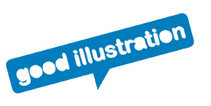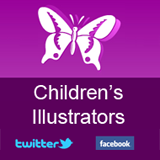Could you tell us a little about your professional background?
After graduating from Tulane University, I had a brief stint working at The Metropolitan Museum of Art, but my first publishing job was at Random House as an editorial assistant. Fortunately for me, the books I worked on did not contain much copy (I am terrible at grammar!), but were primarily journals, calendars, and interesting gifty type books. They were design-driven, which allowed me to work a bit with designers…and after a year or so I realized that I was on the wrong side of the creative process. Luckily for me, I was able to talk my way into a design assistant job with the promise that I would take design classes at night and learn on the job. From then on out, I tried to work for people whose design I respected, and eventually landed at Dial Books for Young Readers, first as a designer, and eventually, as the art director. It has been a really great fit. Looking back, I feel enormously lucky that I ended up working in children’s books. I always thought I would probably end up in some musty museum, but as life has taught me, you can’t plan everything.
On average, how many children’s books does Dial Books produce per year?
Dial publishes around 50 books a year. About a third of the books on the list are novels and the rest are picture books. Basically, if you are between 2 months and 17 years, we’ve got you covered.
How many illustrators do you typically work with per year and roughly what percentage of these are located outside the U.S?
We work with around 35-40 illustrators a year. Most of them live in the U.S., but quite a few are overseas or in Canada. Email, FTP sites, phone, and fax machines really allow us to work with anyone anywhere. As long as we can send our ideas back and forth, location does not matter. What matters is finding the perfect illustrator to work with us on one of our books.
Which industry events do you regularly attend, and are there any trade magazines which are of particular interest to you in your role as Art Director?
I try to attend as many events as possible. I particularly like to go to student illustration events—sometimes I will speak to an illustration class and critique portfolios, or attend the student gallery shows. It is always exciting to find someone who is just starting out, who hasn’t created a book yet. I also go to SCBWI conferences and shows at the Society of Illustrators. The Society has an exhibition dedicated to children’s books called The Original Art Show, which is a wonderful opportunity to see an abundance of beautiful artwork that has been created in the last few years. There is always something new.
In terms of trade magazines, I read Publishers Weekly just to see what is going on in the business, but no one magazine stands out to me as reference. Usually I go to bookstores and look at books for inspiration.
Tell us about a recent project you have worked on, the stages involved and why you chose the selected illustrator(s).
Well, I recently art directed and designed an edition of Alice’s Adventures in Wonderland by Alison Jay. Our publisher, Lauri Hornik, thought that Alison would be the prefect artist to give this old favorite a new spin. I was thrilled, since I had worked with Alison on other books, and know what a lovely person she is to work with. We decided to do an unabridged version, which really gave Alison free reign to illustrate what she wanted, the only parameters that there would be no more than two spreads of text in a row without art, and that there should be a mixture of vignettes, single pages, and full page spreads of artwork in each chapter. We then went through a few dummies to make sure the art was falling correctly and was well spaced. I got so immersed, I even went through a phase where I kept calling Alison “Alice” by mistake—and even designed an early mock-up of the cover that said “Alison’s Adventures in Wonderland!” But I digress. . . Alison’s finals were quite beautiful and reminiscent of the Alice we all grew up with, but she added a new magical quality that made the book feel like it had been created for the first time.
Within the last couple of years, which children’s book has been the most successful for Dial Books and why?
Both Snowmen at Night and Snowmen at Christmas, by the wife and husband team Caralyn and Mark Buehner, have been very successful for Dial. They are timeless books that engage every child’s imagination. I know when I was young, I assumed little animals had completely separate lives than what we saw. I thought they put on their wee waistcoats and sat down for tea as soon as they were out of sight. I think these snowmen books work on this level. They ask us “What do snowmen do at night?” The answer is quite humorous—they really are up to everything from snowball fights, drinking cold cocoa, and partaking in some pretty ambitious sledding.
How many members of staff are there at Dial Books and of these how many work within the creative department?
15 people work at Dial. This includes the editorial, managing editorial, and design staff, but not the countless sales, production, marketing and publicity people who help us with our books. There are 7 people in the editorial department and 5 of us in the design department.
What (if anything) would make you not want to work with a particular illustrator?
Inflexibility would have to be my biggest pet peeve. Creating a book is a collaborative process, and there needs to be room for back and forth to allow for many ideas to take root. We ask an artist to illustrate one of our books because we think they are talented and trust them to break down a story and create a visual narrative, but they also have to trust our input as well. If they are not open to this, then it becomes a frustrating experience. Fortunately those situations are few and far between.
How are Dial Books royalties and advances structured?
It really depends on the project. Typically, for our picture books, each the author and the illustrator receives an advance, and each receives a royalty percentage. For a novel, the author receives an advance and royalties, while the illustrator of the cover receives a flat fee. Sometimes if we have interior illustrations in a novel, the illustrator will receive a small royalty, too.
Of the titles you have been personally responsible for, which one are you most proud of and why?
Eek! That is a tough question. It is hard to single any one book out because I have worked on some really great books by a myriad of talented illustrators. I guess I could pick two that I recently worked on: The Little Red Fish by Taeeun Yoo, and Stick by Steve Breen. Since both of these titles are also written by the illustrator, it allowed for a unique collaborative experience. Both illustrators created very fresh yet classic stories, and the editor and I would work in tandem with them, shaping the books as we went along. At times each of the books are wordless, allowing the art and the visual narrative to shine through. The whole process was very organic and enjoyable.
What can we expect from Dial Books in the future?
Why, wonderful books, of course! And hopefully we will have found some brand new authors and illustrators to introduce you to!
This interview has been syndicated courtesy of Childrensillustrators.com







